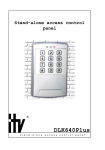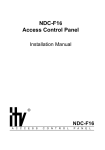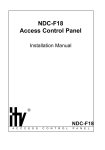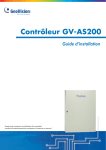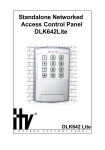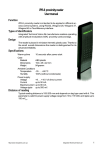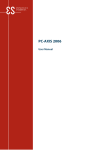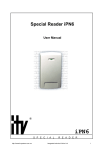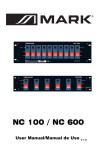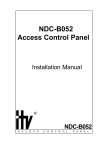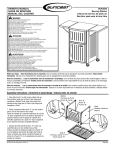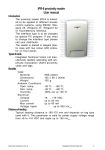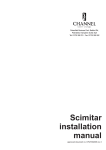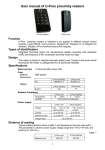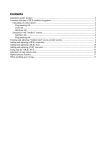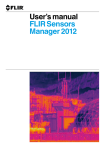Download DLK642
Transcript
Access Control Panel DLK642 Installation Manual ® DLK642 A C C E S S C O N T R O L P A N E L 2 Integrated Technical Vision Ltd http://www.itvsystems.com.ua This manual covers installation, programming and utilization of DLK642 access control panel. Read this manual carefully prior to installing and programming the unit. Design Change Disclaimer Information due to design changes and product improvements in this manual is the subject to change without notice. ITV reserves the right to change the product design any time, that will subsequently affect the contents of this manual. ITV assumes no responsibility for any mistakes that can appear in the manual. The company guarantees that this Installation Manual is up to date and corresponds with the unit you purchase. Reproduction Disclaimer All rights to this document are preserved by Integrated Technical Vision Ltd. Copying, printing and any other kind of unauthorised reproduction of this document or a part of it is prohibited. Trademarks ITV® is a registed trademark of Integrated Technical Vision Ltd. Training and technical support Integrated Technical Vision Ltd provides training in installation, programming and utilisation of DLK642 access control panel. For detailed information about the training and discussing of our particular requirements to the unit please contact our personnel by the phone numbers below. It is recommended, for the staff intended for sales and installation of DLK642 access control panel, to take instruction courses conducted by ITV company. Technical support for all products of Integrated Technical Vision Ltd can be obtained on business time by the following phones: +380(0)44 248 65 88 +380(0)44 248 65 89 +380(0)44 248 65 90 This support assumes the calls of trained specialists. End users must apply to their dealers or installers before phoning us. This information is available on our web site www.itvsystems.com.ua http://www.itvsystems.com.ua Integrated Technical Vision Ltd 3 Contents Preface.....................................................................................................................5 Features...................................................................................................................5 Specifications...........................................................................................................5 Terms........................................................................................................................7 What's inside............................................................................................................9 Controls and connections on board........................................................................11 Control Panel Operation.........................................................................................12 Main Mode ............................................................................... .................12 Alarm Mode ............................................................................. .................13 Free Pass Mode ...................................................................... .................14 Blocked Mode ......................................................................... .................14 Mounting..................................................................................................................15 Wiring......................................................................................................................15 Limited Warranty.....................................................................................................20 4 Integrated Technical Vision Ltd http://www.itvsystems.com.ua Features Preface DLK642 is an access control panel which operates as totally stand-alone unit with a fully distributed database. All valid card numbers, time zones and relay pulse times are loaded to control panel memory. The panel can control access into two doors with no dependency on a central computer system. Primary goals of Access Control System are: identification of a person, confirmation or not confirmation of access, control of movements in a necessary zone. It can provide time and attendance logging, in addition to usual task of restricting individuals’ access to certain areas. All users' access information is captured on a server, where system managers can retrieve and analyse the information. This data provides recording of staff movement within an organization, whether it is a small company or a company that employs thousands. Features • Supports all Wiegand reader technologies • Distributed database for independent operation • Operates in remote site configurations with dial-up (requires NDC-B052) • Card, keypad or card and keypad access support • On-board lithium battery for data storage • 4-wire RS-485 • 8 supervised programmable inputs • Tamper alarm • 2 Form C relays • Two transistor outputs • Nonvolatile memory • Local antipassback function • Built-in buzzer Specifications • Inputs 8 programmable EOL supervised inputs • Outputs • Two 5 A @ 24 V relays • Two open drain outputs 0.5 A @ 24V (with multifuse protection) • Networking RS485 interface • EPROM: • Identificators 1024 • Events 1920 • Time zones up to 250 • Schedules up to 250 • Holidays up to 250 • Input Voltage http://www.itvsystems.com.ua +10…15 VDC Integrated Technical Vision Ltd 5 Specifications • Voltage ripple 500 mV @ 12 V • Power consumption: • Standby current 80 mA@ 12V • Maximal current 130 mA@ 12V • Environmental requirements: • Operation temperature 0 °С … +55 °С; • Relative Humidity 80% relative at +35°С; • Physical dimensions: • Width 6 155mm • Height 95mm • Depth 32mm • Weight 0,25 kG Integrated Technical Vision Ltd http://www.itvsystems.com.ua Terms Terms Access point Access point is a logical concept of the access control system implying control of passing through a door in one direction. It consists of reader, access control panel (or its part), door supervision devices (like magnetic sensor, RTE etc.) and door locking device. For instance, the turnstile with two way passes has two Access points – one for entrance and the other one for exit, door of this type is called double-sided door. A door with a reader on one side has only one Access point – Entry point, and it is called single-sided door. Antipassback Antipassback function is implemented in DLK642 access control panel in order to prevent the situation when user gives his ID to another person after passing into the premises. If this function is on, DLK642 tracks an ID position – Inside or Outside the premises. On any attempt to pass in the same direction twice DLK642 denies access and stores “Access Denied, Antipassback” event into the Log. Antipassback function can be set on only in case of the double-sided door control. Code matching DLK642 can activate alarm on attempt of a code (or ID) matching. Code matching is considered when invalid code (or ID) is entered several times succesively. Valid code entering clears the counter. This function switching on and number of code entrances are subjects of programming. Door Contact (DC) In access control systems various sensors are used to supervise door status (opened or closed) – magnetic door sensor, sensor of the turnstile rotor position, inductive sensor of car passing through the road barrier, etc. Door Contact terminal of DLK642 is intended for connection of these sensors. Door time If door sensor is open, corresponding access point goes into alarm. Alarm is not invoked, if contact is opened during Door Time interval. This interval starts when access is granted and lasts for the programmed time or terminates on opening and subsequent closing of door contact. Downloading DLK642 is to be downloaded after all parameters setting – modes of inputs, outputs, access rights and others on PC. During downloading parameters are rewritten into access control panel. If you change control panel parameters in your computer, they will not take effect until this parameters are downloaded to control panel. PIN (Personal Identification Number) Some readers have built-in keypad. Keypad may be used for PIN entering. It can be both self dependant or used as an additional code to ID. When PIN is programmed as additional code, DLK642 waits for PIN entering after ID is read-out. PIN is associated with ID. http://www.itvsystems.com.ua Integrated Technical Vision Ltd 7 Terms Proximity Identificator In access control systems each user has ID (identificator) with unique code. Proximity IDs may be in shape of plastic card, keytrinket, etc. Reader Readers are devices assigned for reading information from IDs and transmitting it to control panel There are several types of IDs and readers for them. It is essential that reader and control panel should use the same interface. DLK642 utilizes Wiegand interface. RTE (Request to Exit) To exit from the premises with a single-sided door, a button wired to control panel is used. This button is called RTE (Request To Exit) button. If someone opens a door otherwise than pressing RTE button – by re-energising locking device, opening lock with a key etc., "Door Forced Open" event arises. RTE button may be used for remote door opening as well. Schedules DLK642 is capable to store up to 250 time zones. 250 week schedules can be combined from these time zones. Moreover DLK642 can store several “floating” schedules, based on a period different to a week. The number of such “floating” schedules depends on period length. “Several IDs' access To enter high security premises presence of more than one person may be required . DLK642 allows to assign up to 15 groups of people with the access rights. Access is granted only in case when one person from each group is present. For instance you have the room which can be attended only by personnel of R&D department escorted with guard. You can form two groups for this access – group of R&D employees and group of guard. Access is granted if two IDs from different groups read by panel readers – one belongs to R&D department employee and the other one – is a guardian. Time zone Any interval of time which has the beginning and the end. 8 Integrated Technical Vision Ltd http://www.itvsystems.com.ua What's inside What's inside General Configuration The layout of DLK642 is shown on Diagram1 below. 1 2 a) 5 3 4 Z6 GND Z5 Z4 GND Z3 Z2 GND Z1 GND + ER BZ D1 D0 GN RD X2 S5 X3 X2 S8 S9 6 RST BAT DLK 642 S6 VL1 S3 S4 X1 A + B- GND + EB Z7 GND Z8 -PW R+ TM NC1 C1 NO1 NC2 C2 NO2 SA BEL б) Figure1. a). General view of DLK642, b) DLK642 with front cover off 1 - LEDs, 2 - built-in reader, 3 - backplate, 4 - panel's PCB, 5 - PCB of the reader, 6 - front cover. http://www.itvsystems.com.ua Integrated Technical Vision Ltd 9 What's inside Wiring Configurations External reader RS485 PC Z6 GN D Z5 Z4 GN D Z3 Z2 GN D Z1 GN D + ER BZ D1 D0 GN RD X2 S5 X3 X2 S8 PCB of built-in reader S9 RST BAT DLK 64 2 VL1 S6 Panel's PCB S3 S4 X1 A + B- GN D + EB Z7 GN D Z8 -PW R+ TM N C1 C1 N O1 N C2 C2 N O2 SA BEL Bell Ba Locks or strikes at us us St at St ns ry ai tte M Door Contacts RTE's button Free Pass button Door Blocking button Power Supply +12 В Figure2.Terminals layout. 10 Integrated Technical Vision Ltd http://www.itvsystems.com.ua Controls and connections on board Controls and connections on board Terminals' assignment Terminal block X1 Terminal A+ BGND +EB Z7 GND Z8 - PWR+ TM NC1 C1 NO1 NC2 C2 NO2 SA BEL X2 Function Description RS485- A RS485- B RS485 dropline RS- 485 Common +12 RS485 Zone7 Common EOL supervised programmable inputs 7, 8 connection Zone8 T e r m i n a ls for connecting power supply Power Tamper Contact Tamper contact output (Normally closed) Normally closed Common Relay 1 contacts Normally open Normally closed Common Relay 2 contacts Normally open Transistor output +12 V @ 0,3A For connection of executional Transistor output (open devices drain) @ 0,3A Z6 GND Z5 Z4 GND Z3 Z2 GND Z1 GND +EB BZ D1 D0 GN RD http://www.itvsystems.com.ua Zone 6 GND Zone 5 Zone 4 GND Zone 3 Zone 2 Common Zone 1 -12V + 12 V Buzzer control DATA 1 DATA0 Green LED control Red LED control 1-6 EOL inputs' connection Reader connection terminals Integrated Technical Vision Ltd 11 Control Panel Operation Jumpers and LED - RST - Reset jumper - S3, S4, S6 - Jumpers for RS-485 load selection - S5 - Tamper - BAT - Real-time clock power switch - S8, S9 - Reader mode (Wiegand/Special reader) setting jumpers - VL1 - Live function indicator Jumper BAT should be shorted before installation and broken during transportation and storage. Control Panel Operation Control panels are supplied unprogrammed. In this state reader LEDs do not light. VL1 panel yellow LED blinks 5 times per second. Panel does not respond to IDs' passing and inputs' opening and closing. A panel should be downloaded to start operation mode with DC Configurator or Golden Gate program. Yellow LED starts to blink one time per second and switches to the main mode automatically after successful settings' downloading. Panel can be turned to the unloaded status only with command from PC, see programming instruction. Panel can control two independent access points. Each access point may be in one of four modes: main mode, alarm, blocked or free pass. Free pass mode has the highest priority, as panel switches to this mode in case of fire; then blocked, alarm and main modes follow. Main Mode Panel grants or denies access to cardholders in this mode. In Main mode reader's LEDs blink red. Access with ID To access the premises cardholder passes identificator to a reader. If it is valid a panel grants access, unlocks a door and green LED switches on. Access with ID and PIN To access the premises cardholder passes ID to the reader. The panel checks necessity of PIN entering and if it is necessary, reader starts to blink yellow, that means PIN entering is awaited. After valid PIN entering door is unlocked, reader's LED lights green. Using RTE To exit out of the premises with a single-sided door, users have to depress (press & release) Request to Exit button. Reader and panel LEDs light green. “Several IDs” access To access the high security premises, bank depot for instance, the presence of more than one person may be required. At least two people should enter the depot, for example a board member escorted with a guard. You can program the panel thus access will be granted after two cards of different groups are passed to the reader. 12 Integrated Technical Vision Ltd http://www.itvsystems.com.ua Control Panel Operation Access Denial Access may be denied for the following reasons (LED lights red): - Panel is not downloaded (LED does not light or blink) - ID is not enrolled (red LED and buzzer switch on for a second) - ID time expired (red LED and buzzer switch on for a second) - Access is prohibited at the present moment/day (red LED and buzzer switch on for a second) - Attempt of repeated access with Antipassback function switched on (red LED and buzzer switch on for a second) - Lost or blocked ID is passed (red LED and buzzer switch on for a second) - The panel is in Alarm mode (red LED lights uninterruptedly) - The panel is in Blocked mode ( LED blinks red and yellow) - Attempt of code matching (if the function was switched during programming) In Alarm mode panel activates outputs assigned for Bell and Alarm. Alarm output is deactivated when panel switches into a mode different to alarm. Bell output is deactivated after programmed time. If access point is in Alarm state it is prohibited to pass through this point. RTE button unlocks a door. To switch Alarm mode off pass ID card with “Alarm off” sign or give a command from PC. Alarm Mode In alarm mode reader red LED lights constantly. Access point switches into Alarm mode for following reasons: - In case of door ajar - Attempt of access with lost ID - If door is opened too long (door time expired) - In case of attempt of code matching (if switched on during programming). Access point does not go into alarm mode in case of panel box tampering, alarm output activates only. You can forbidd access point change into Alarm mode in case of "Door opened too long" event. The prohibition can be programmed for each door separately. In alarm mode panel activates outputs assigned for BELL and ALARM. Alarm output is deactivated when panel switches into a mode different to alarm mode and it is recommended to program duration time for BELL output. If access point is in alarm mode passing through this point is prohibited. RTE button unlocks the door. To switch alarm mode off pass ID with “Alarm OFF” sign or switch it off with command from computer. http://www.itvsystems.com.ua Integrated Technical Vision Ltd 13 Control Panel Operation Free Pass Mode Sometimes situations arise when a door should be open for free pass to everyone, e.g. in case of fire, earth quake or any other disaster. For such cases the panel has Free Pass mode. In this mode reader LED blinks green and yellow alternately. Access point switches into Free Pass mode with PC operator command or if an input, programmed as “Free Pass”, is violated. Access point is in Free Pass Mode until this input is open or operator cancels the mode. While Access point is in Free Pass mode the locking device is locked and the panel does not respond to IDs' passing, PIN entry or RTE button pressing. The control panel allows you assigning of Free Pass function to an input for one access point A, B or two access points together (A + B). Blocked Mode Blocked Mode is intended for use in situations when access to the premises should be prohibited for everyone, in case of security alarm for instance. When Access point is in the Blocked mode access is granted only to IDs with “Security Service” sign. Door cannot be unlocked with RTE button. During Blocked mode time reader LED blinks red and yellow alternately. Access point switches into Blocked mode with PC operator command or when input, programmed as “Blocking” is violated. Access point remains in Blocked mode while this input is violated or operator cancels the mode. The control panel allows you assigning of Blocking function to an input for one access point A, B or two access points together (A + B). 14 Integrated Technical Vision Ltd http://www.itvsystems.com.ua Mounting Mounting Design and view of DLK642 access control panel allow to mount it directly at a door and use built-in reader and keypad. It should be stationed at access point at a height, convenient for all users. While mounted on metal surface, reading range decreases. Do not mount the panel or lay wires closely to mains power wiring and other sources of electromagnetic interference. To mount the panel on a wall proceed as follows: - Release the screw in the lower part of cover (Figure 3a) - Lift front cover slightly in the bottom part and pull it downwards (Figure 3b) Fixing holes D1 D0 GN RD Z6 GND Z5 Z4 GND Z3 Z2 GND Z1 GND + ER BZ X2 S5 X3 X2 S8 S9 RST BAT DLK 64 2 S6 VL1 S3 S4 X1 A + B- GND + EB Z7 GND Z8 -PW R+ TM NC1 C1 NO1 NC2 C2 NO2 SA BEL 5...10мм Wirihg holes Fixing tabs a) b) c) d) Figure3. DLK642 mounting specifications. While istalling the panel set jumper BAT into lower position before programming. Set it into upper position for a long term storage and trasportation. Wiring Connecting readers DLK642 can control two access points using two readers, one is built-in reader the other one is external reader. They can be readers produced by ITV Ltd or other readers with Wiegand interface. X2 terminal block is intended for access point A (entrance in case of double-sided door) reader connection. It can be iPN series reader or another one with Wiegand interface. X3 terminal is intended for access point B (exit in case of double-sided door) reader connection. Reader and controller are to be mounted on wall directly at a door at convenient height. http://www.itvsystems.com.ua Integrated Technical Vision Ltd 15 Wiring The wiring is shown on Diagram below. Built-in reader iPN series connection special reader cord Built-in reader connection cord black red blue black red blue S8 S9 white D1 D0 GN RD GN +E BZ D R X2 X3 brown orange green white X3 orange green yellow GN +E BZ D R Wiegand reader D1 D0 GN RD S8 S9 X2 Wires colours can differ in readers of other vendors. Please refer to your reader installation manual. External reader connecting cable length can be increased up to 50 meters by AWG 8x0.22 cable. During increasing of cable length mind the conductors. Do not mount the reader on metal surface. It decreases reading distance. Reader is to be mounted at 50sm minimum distance from controller. Otherwise reading distance will be decreased. Inputs wiring DLK642 has eight EOL inputs. All inputs are programmable - see details in Golden Gate manual. After reset to factory defaults all inputs become unassigned and not supervised. All inputs supervise shortage and break. EOL usage is mandatory. The following input functions are possible: - door sensor (A, B, A+B) - RTE button - door sensor + RTE button - free pass (A, B, A+B) - blocking (A, B, A+B) - state monitoring Input normal state is from 1,4 kOm up to 3 kOm. Input short circuit is less than 1,4 kOm and input break is more than 3 kOm. 16 Integrated Technical Vision Ltd http://www.itvsystems.com.ua Wiring RTE button Request To Exit (RTE) button is to be used in case of single-sided door. In this case door opens on depressing of RTE button. EOL EOL resistor resistor RTE button for access point A RTE button for access point B RTE button may be used for remote door opening - for secretary or guard to open a door, for instance. Z6 GND Z5 Z4 GND Z3 Z2 On the diagram wiring of normally X2 opened RTE button is shown. RTE is wired to Z5 and Z6 terminals. Usage of deblocking button on electric lock instead of RTE buton will cause "Door forced open" event. It is not recommended to use Z7 and Z8 terminals for RTE button connection. Door Sensor S5 EOL Resistor EOL resistor Door Sensor of access pointB Door state (opened or closed) is determined by the state of door sensor. If door sensor is not connected, the panel is not able to determine events of door forced open or unclosed door. Wiring of normally closed door sensors to Z3 and Z4 terminals is shown on X2 wiring diagram. It is not recommended to use Z7 and Z8 terminals for door sensor connection. Door Sensor of access point A Z6 GND Z5 Z4 GND Z3 Z2 S5 Free Pass and Blocking An input may be programmed for Free Pass or Blocking. If input is programmed for Free Pass DoorA & DoorB, Free Pass Door A or Free Pass Door B then shortage or opening of this input unlocks corresponding locking device and personnel can pass freely through the door. EOL FreePass wiring with NC or NO contacts If input is programmed for Blocking, then shortage or breaking of this input discards access rights to all IDs, except for those with “Security service” mark. EOL Blocking wiring with NC or NO contacts Z4 GND Z3 Z2 GND Z1 X2 Wiring of normally closed (NC) or normally open (NO) control panel contacts to Z1 and Z2 terminals is shown S5 on wiring diagram. It is not recommended to use Z7 and Z8 terminals for free pass and blocking iinputs accessing. http://www.itvsystems.com.ua Integrated Technical Vision Ltd 17 Wiring Power supply wiring ~ AC ~ +12 V GND PWG ACG It is recommended to use PSU Z7 GND Z8 -PW R+ TM NC1 C1 NO1 NC2 C2 NO2 1,5 power supply with battery backup, manufactured by ITV Ltd. This power supply provides 12V power rated at DLK642 +12 V 1,5A. 4AH or 7AH battery may be used as well. PSU1,5 power supply has outputs for Rn GND Rn 2 kOm signalling of mains power 2 kOm state and battery state. Wiring ~220 V power normal with mains power and battery state supervising with Z7 and Battery normal Z8 terminals is shown on the picture. Power unit Locking devices DLK642 has two relay outputs with C form contacts. Operation time of this outputs may be programmed from 1 to 255 sec. That allows to BEL Lock of control practically any type of locking device. access Wiring of locking devices is shown on wiring point B diagram. X1 -PWR+ TM NC1 C1 NO1 NC2 C2 NO2 SA Relay contact rating is 5 Amp @ 24 Volts. Commutation of inductive load, electric lock for instance, causes high energy electric impulse induced through relay contacts. To save contacts from damage, protect them with diode, connected in reverse to current supply of the coil. Lock of access point A Note the fact, that some cheap electric door strikes are not intended for being energized for prolonged time. Program relay time as short as possible to avoid door strike coil overheating. Sirens, Bells and agents There are two additional programmable transistor outputs for siren, bell or other agents control. X1 PW R+ TM NC1 C1 NO1 NC2 C2 NO2 SA BEL Bell output is rated at 300 mA @ 12V and sinks to the ground. SA is rated at 300 A @ 12V and sinks to the ground. This outputs are electronically protected against overload. In case of overload corresponding event is generated. Some sirens require polarity observing. Bell +12 V up to 500 мА Electric bells are often the inductive load for power supply. While connecting bells mind the warning about the inductive load above. 18 Integrated Technical Vision Ltd http://www.itvsystems.com.ua Wiring S4 RS-485 Interface GND + EB red B- black A+ blue yellow Unshielded four-wire cable may be used for RS-485 wiring. To obtain the maximal range of 1200 meters use 0.4 mm 2 cross section wire. 0.2 mm two-cross section wire will provide the range of 500 meters . S3 RS-485 Interface is used for networking of the system components - PC and panels. The range of RS-485 bus is up to 1200 meters. The number of panels is up to 32. RS-485 port is protected against overvoltage (60V) and crosspolarity. On the first and last panel in the drop-line short jumpers S3, S4 and S6 to add the resistive load. Take care of proper grounding of all panels in the network. Adress setting Jumpers shorted RS232 RS485 LNET RS485 Each panel on RS-485 drop line must have the unique address from 0 to 31. X1 To set panel's address proceed as follows: Z8 -PW R+ T NC1 C1 NO1NC2 C2 NO2 SA BEL M 1. Disconnect feeding of the panel 2. Short terminals TM and BEL 3. Supply feeding. Buzzer will beep several times and current address settings will be displayed with buzzer beeps and right green LED blinks. The digit is displayed as number of beeps and blinks with a pause between digits. For example, number 23 is displayed as: 2 beeps and right green LED blinks, pause, 3 blinks and beeps. Zero is displayed with continuous sound and LEDs blink. For example, number 04 is displayed as: 1 continuous sound and right green LED blink then 4 blinks and beeps. After current address settings displaying, all LEDs blink simultaneously. 4. Enter desired address and press [#] button. Two digits have to be entered necessarily, for example address 1 is to be entered as [0][1][#]. 5. Disconnect feeding of the panel 6. Remove shortage from TM and BEL terminals Panel is ready for operation with new address. http://www.itvsystems.com.ua Integrated Technical Vision Ltd 19 Z Limited Warranty Limited Warranty Integrated Technical Vision Ltd. warrants that for a period of eighteen months from the date of purchase, the product shall be free of defect in materials and workmanship under normal use and that in fulfilment of any breach of such warranty, Integrated Technical Vision Ltd. shall, at its option, repair or replace the defective equipment upon return of the equipment to its repair depot. This warranty applies only to defects in parts and workmanship and not damaged incurred in shipping or handing, or damaged due to causes beyond the control of Integrated Technical Vision Ltd. such as lightning, excessive voltage, mechanical shock, water damage, or damage arising out of abuse, alteration or improper application of the equipment. The foregoing warranty shall apply only to the original buyer, and is and shall be lieu of any and all other warranties, whether expressed or implied and of all other obligations or liabilities on the part of Integrated Technical Vision Ltd. This warranty contains the entire warranty. Integrated Technical Vision Ltd. neither assumes, nor authorizes any other person purporting to act on its behalf to modify or to change this warranty, nor to assume for it any warranty or liability concerning this product. 071004 In no event shall Integrated Technical Vision Ltd. be liable for any direct, indirect or consequential damages. Loss of anticipated profits, loss of time or any other losses incurred by the buyer in connection with the purchase, installation or operation or failure of this product. 20 Integrated Technical Vision Ltd http://www.itvsystems.com.ua




















